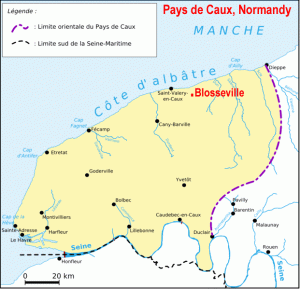Gilbert de Blosseville
Gilbert de Blosseville is the first Harrold person whose name is to be found in written historical records. He had earned himself the right to hold the manor of Harrold from the Countess of Huntingdon, Judith of Lens (niece of William the Conqueror]. The details of this are recorded in The Domesday Book compiled in 1086.
We do not know what service Gilbert had provided in the 1066 Norman Conquest of England, but this was likely to have been as a knight or soldier (his name is not mentioned as a financial supporter or equipment provider of the campaign and such providers received huge rewards, sometimes the lordship of hundreds of manors). Gilbert’s share was the manor of the smallest village in the Hundred of Willey (in 1086 there were just 10 houses in Harrold, at least half that of many surrounding villages), but the manor was itself sizeable and with much potential. He also received a smaller amount of land in nearby Lavendon.
Nineteenth Century engravings on the wall of the church of Dives in Calvados, Normandy include the name of Gilbert de Blosseville as one of “The Companions of William” at the Battle of Hastings.
 Gilbert arrived in Harrold probably only in his late teens. He was born around 1050 in Blosseville in Upper Normandy (15 miles west of Dieppe and now in the Pays de Caux, a region of the Seine-Maritime department). Even today Blosseville is a small farming community of just over 200 people. The area is a stronghold of Norman French language and the regional dialect of the Pays de Caux is Cauchois. One can, therefore, only imagine the difficulties of a 17 year old Cauchois-speaking Norman settling into life in Saxon Harrold, where he replaced three English thanes in the new feudal system.
Gilbert arrived in Harrold probably only in his late teens. He was born around 1050 in Blosseville in Upper Normandy (15 miles west of Dieppe and now in the Pays de Caux, a region of the Seine-Maritime department). Even today Blosseville is a small farming community of just over 200 people. The area is a stronghold of Norman French language and the regional dialect of the Pays de Caux is Cauchois. One can, therefore, only imagine the difficulties of a 17 year old Cauchois-speaking Norman settling into life in Saxon Harrold, where he replaced three English thanes in the new feudal system.
Gilbert was not an absentee landlord though: he raised a family in Harrold. His son, William de Blosseville , was born here in 1080 and was still in Harrold in 1129 when he died. Like his father he, too, was probably a soldier of fortune. A William de Blosseville was a successful knight in the Norman conquest of the Kingdom of Sicily. In 1103 this William de Blosseville re-conquered The Southern Italian state of Gaeta and was made Consul and Duke of Gaeta. Within two years he had been deposed and exiled following defeat by Richard II of Aquila. The 25 year-old soldier of fortune probably then returned to a safer Norman territory back in Harrold. There is no great evidence to suggest that these were the same two people, but it might go some way to explain why he was later in a position to arrange for his daughter, Albreda, to marry Payn de Braose, a member of one of the most powerful families in Norman England. Albreda de Blosseville was born in Harrold in 1113.
The Harrold line then continues through the de Braose name to their son Robert and his daughter Albreda de Braose who married Ralph de Morin who held the manor of Harrold, as did his son, also Ralph de Morin. Thus Harrold manor rested in the hands of Gilbert de Blosseville and his descendants for two centuries.
The de Blosseville family grew in size and influence over the county border in Buckinghamshire. The village of Newton Blossomville derives its name from Jordan de Blosseville. A descendant of Jordan was Gilbert II de Blosseville who became known as Gilbert de Hameldon which became corrupted to de Hamilton and this was the origin of the powerful Scottish barons. His son Walter FitzGilbert de Hamilton acquired land in Scotland by exchanging some of his Buckinghamshire holdings. Soon Blosseville families became influential in other parts of England, including Lincolnshire, Suffolk and Norfolk.
Meanwhile back in Harrold, a descendant of the de Blossevilles, Naomi (?) Morin (b. 1254) married John de Pabenham, a member of a notable local family and whose descendants include many of the great aristocratic families. Some 25 generations separate the arrival of Gilbert in Harrold from his descendant, Elizabeth who celebrated her Diamond Jubilee in 2012. In addition to shared genes, the Queen and Gilbert de Blosseville would have one thing in common, they would both understand some words of Norman French, as the Queen uses that language to give her formal assent to a parliamentary bill.
See also
Domesday Entry of 1086: Gilbert de Blosseville is named in the Harrold entry (the earliest written record of a Harrold person).
Ancestry of Ralph de Morin the Younger
